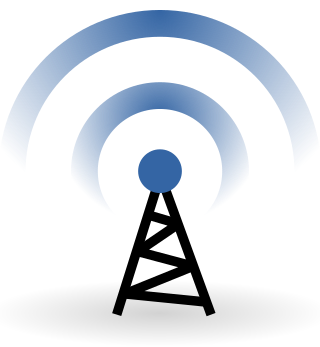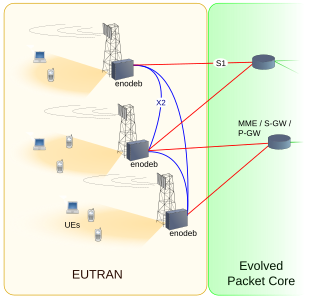
Code-division multiple access (CDMA) is a channel access method used by various radio communication technologies. CDMA is an example of multiple access, where several transmitters can send information simultaneously over a single communication channel. This allows several users to share a band of frequencies. To permit this without undue interference between the users, CDMA employs spread spectrum technology and a special coding scheme.

Digital enhanced cordless telecommunications , usually known by the acronym DECT, is a standard primarily used for creating cordless telephone systems. It originated in Europe, where it is the common standard, replacing earlier cordless phone standards, such as 900 MHz CT1 and CT2.

Time-division multiple access (TDMA) is a channel access method for shared-medium networks. It allows several users to share the same frequency channel by dividing the signal into different time slots. The users transmit in rapid succession, one after the other, each using its own time slot. This allows multiple stations to share the same transmission medium while using only a part of its channel capacity. Dynamic TDMA is a TDMA variant that dynamically reserves a variable number of time slots in each frame to variable bit-rate data streams, based on the traffic demand of each data stream.
The Universal Mobile Telecommunications System (UMTS) is a third generation mobile cellular system for networks based on the GSM standard. Developed and maintained by the 3GPP, UMTS is a component of the International Telecommunication Union IMT-2000 standard set and compares with the CDMA2000 standard set for networks based on the competing cdmaOne technology. UMTS uses wideband code-division multiple access (W-CDMA) radio access technology to offer greater spectral efficiency and bandwidth to mobile network operators.

A wireless network is a computer network that uses wireless data connections between network nodes.
In telecommunications and computer networks, a channel access method or multiple access method allows more than two terminals connected to the same transmission medium to transmit over it and to share its capacity. Examples of shared physical media are wireless networks, bus networks, ring networks and point-to-point links operating in half-duplex mode.
4G is the fourth generation of broadband cellular network technology, succeeding 3G and preceding 5G. A 4G system must provide capabilities defined by ITU in IMT Advanced. Potential and current applications include amended mobile web access, IP telephony, gaming services, high-definition mobile TV, video conferencing, and 3D television.

A cell site, cell tower, or cellular base station is a cellular-enabled mobile device site where antennas and electronic communications equipment are placed to create a cell, or adjacent cells, in a cellular network. The raised structure typically supports antenna and one or more sets of transmitter/receivers transceivers, digital signal processors, control electronics, a GPS receiver for timing, primary and backup electrical power sources, and sheltering.

A cellular network or mobile network is a communication network where the link to and from end nodes is wireless. The network is distributed over land areas called "cells", each served by at least one fixed-location transceiver. These base stations provide the cell with the network coverage which can be used for transmission of voice, data, and other types of content. A cell typically uses a different set of frequencies from neighboring cells, to avoid interference and provide guaranteed service quality within each cell.

The history of mobile phones covers mobile communication devices that connect wirelessly to the public switched telephone network.
This article discusses the mobile cellular network aspect of teletraffic measurements. Mobile radio networks have traffic issues that do not arise in connection with the fixed line PSTN. Important aspects of cellular traffic include: quality of service targets, traffic capacity and cell size, spectral efficiency and sectorization, traffic capacity versus coverage, and channel holding time analysis.
Spectral efficiency, spectrum efficiency or bandwidth efficiency refers to the information rate that can be transmitted over a given bandwidth in a specific communication system. It is a measure of how efficiently a limited frequency spectrum is utilized by the physical layer protocol, and sometimes by the medium access control.
The air interface, or access mode, is the communication link between the two stations in mobile or wireless communication. The air interface involves both the physical and data link layers of the OSI model for a connection.

E-UTRA is the air interface of 3rd Generation Partnership Project (3GPP) Long Term Evolution (LTE) upgrade path for mobile networks. It is an acronym for Evolved Universal Mobile Telecommunications System (UMTS) Terrestrial Radio Access, also referred to as the 3GPP work item on the Long Term Evolution (LTE) also known as the Evolved Universal Terrestrial Radio Access (E-UTRA) in early drafts of the 3GPP LTE specification. E-UTRAN is the initialism of Evolved UMTS Terrestrial Radio Access Network and is the combination of E-UTRA, user equipment (UE), and E-UTRAN Node B or Evolved Node B (eNodeB).

This is a comparison of standards of mobile phones. A new generation of cellular standards has appeared approximately every tenth year since 1G systems were introduced in 1979 and the early to mid-1980s.
In radio resource management for wireless and cellular networks, channel allocation schemes allocate bandwidth and communication channels to base stations, access points and terminal equipment. The objective is to achieve maximum system spectral efficiency in bit/s/Hz/site by means of frequency reuse, but still assure a certain grade of service by avoiding co-channel interference and adjacent channel interference among nearby cells or networks that share the bandwidth.
Radio resource management (RRM) is the system level management of co-channel interference, radio resources, and other radio transmission characteristics in wireless communication systems, for example cellular networks, wireless local area networks, wireless sensor systems, and radio broadcasting networks. RRM involves strategies and algorithms for controlling parameters such as transmit power, user allocation, beamforming, data rates, handover criteria, modulation scheme, error coding scheme, etc. The objective is to utilize the limited radio-frequency spectrum resources and radio network infrastructure as efficiently as possible.

A mobile phone signal is the signal strength received by a mobile phone from a cellular network. Depending on various factors, such as proximity to a tower, any obstructions such as buildings or trees, etc. this signal strength will vary. Most mobile devices use a set of bars of increasing height to display the approximate strength of this received signal to the mobile phone user. Traditionally five bars are used.
The Mobile Telephone Switching Office (MTSO) is the mobile equivalent of a PSTN Central Office. The MTSO contains the switching equipment or Mobile Switching Center (MSC) for routing mobile phone calls. It also contains the equipment for controlling the cell sites that are connected to the MSC.
In cellular telecommunications, handover, or handoff, is the process of transferring an ongoing call or data session from one channel connected to the core network to another channel. In satellite communications it is the process of transferring satellite control responsibility from one earth station to another without loss or interruption of service.










